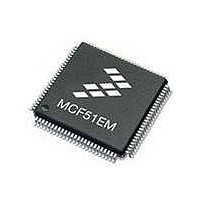MCF51EM256CLL Freescale Semiconductor, MCF51EM256CLL Datasheet - Page 420

MCF51EM256CLL
Manufacturer Part Number
MCF51EM256CLL
Description
IC MCU 32BIT 256KB FLASH 100LQFP
Manufacturer
Freescale Semiconductor
Series
MCF51EMr
Datasheets
1.MCF51EM128CLL.pdf
(2 pages)
2.MCF51EM128CLL.pdf
(54 pages)
3.MCF51EM128CLL.pdf
(636 pages)
Specifications of MCF51EM256CLL
Core Processor
Coldfire V1
Core Size
32-Bit
Speed
50MHz
Connectivity
I²C, SCI, SPI
Peripherals
LCD, LVD, PWM, WDT
Number Of I /o
63
Program Memory Size
256KB (256K x 8)
Program Memory Type
FLASH
Ram Size
16K x 8
Voltage - Supply (vcc/vdd)
1.8 V ~ 3.6 V
Data Converters
A/D 16x12b
Oscillator Type
External
Operating Temperature
-40°C ~ 85°C
Package / Case
100-LQFP
Processor Series
MCF51EM
Core
ColdFire V1
Data Bus Width
32 bit
Data Ram Size
16 KB
Interface Type
RS-232, LIN
Maximum Clock Frequency
50 MHz
Number Of Timers
3
Operating Supply Voltage
1.8 V to 3.6 V
Maximum Operating Temperature
+ 85 C
Mounting Style
SMD/SMT
3rd Party Development Tools
JLINK-CF-BDM26, EWCF
Development Tools By Supplier
DEMOEM
Minimum Operating Temperature
- 40 C
Lead Free Status / RoHS Status
Lead free / RoHS Compliant
Eeprom Size
-
Lead Free Status / Rohs Status
Lead free / RoHS Compliant
Available stocks
Company
Part Number
Manufacturer
Quantity
Price
Company:
Part Number:
MCF51EM256CLL
Manufacturer:
FREESCALE
Quantity:
110
Company:
Part Number:
MCF51EM256CLL
Manufacturer:
Freescale Semiconductor
Quantity:
10 000
- Current page: 420 of 636
- Download datasheet (11Mb)
Independent Robust Real Time Clock (IRTC)
17.7
17.7.1
17.7.2
17.7.3
17-36
•
•
•
•
•
•
•
•
•
•
•
•
•
•
•
•
•
•
This is the initial flow that needs to be done after every power-on reset
CPU sets the date and time into the IRTC registers
CPU sets other control information needed for IRTC to function
CPU enables the various interrupts and alarm time as per its requirements
CPU stores in the Standby RAM inside IRTC, any critical data needed to be preserved in the event
of main voltage loss. This can be done during normal operation too.
IRTC has configuration bits that can be used for application dependent protocol and these bits need
to retain state during mains voltage removal. These are programmed by the CPU
CPU enables the tamper control bits. If not, this is done after 15 seconds of power on.
Once the complete configuration of IRTC is done, the CPU should put the IRTC in write protect
state. If not, this is automatically done after 15 seconds of power on.
During the Normal Operation of IRTC, all write accesses to registers are blocked. Only by
following the unlock sequence mentioned in Register Description can CPU get the write access and
modify the contents on the registers.
During the normal operation, any interrupt might occur or the Standby RAM needs to be updated
or some control information needs to change.
Any such operation should be preceded by the Unlock Sequence mentioned above.
Interrupts can occur when the time in counters match the value in alarm registers or when a
sampling timer expires or a tamper is detected
CPU should service these interrupts and then put the IRTC back in write-protect mode. If not, write
protect is enabled 2 seconds after unlock.
Standby operation is defined as operation of IRTC on battery voltage and no MCU voltage
Whenever the main voltage falls below a certain threshold, the system switches to battery power
and IRTC functions normally.
The switching of power and detection of low voltage threshold of MCU voltage is done in analog
blocks outside the IRTC design. Refer to
Whenever the MCU voltage is restored, the IRTC switches over to this power
If the battery drains out and when the power is supplied again to IRTC (by new battery or CPU
power), a power on reset is sent to IRTC and all registers are reset. Application needs to signal for
re-calibration of the IRTC.
Modes of Operation (Based on Data Flow)
IRTC Configuration
IRTC Normal Operation
IRTC Standby Operation
MCF51EM256 Series ColdFire Integrated Microcontroller Reference Manual, Rev. 8
Section 17.1.1, “IRTC Power Supply
Freescale Semiconductor
Source,” for details.
Related parts for MCF51EM256CLL
Image
Part Number
Description
Manufacturer
Datasheet
Request
R

Part Number:
Description:
BOARD DEMO HARDWARE ONLY
Manufacturer:
Freescale Semiconductor
Datasheet:

Part Number:
Description:
IC MCU 32BIT 128KB FLASH 100LQFP
Manufacturer:
Freescale Semiconductor
Datasheet:

Part Number:
Description:
IC MCU 32BIT 128KB FLASH 80LQFP
Manufacturer:
Freescale Semiconductor
Datasheet:

Part Number:
Description:
IC MCU 32BIT 256KB FLASH 80LQFP
Manufacturer:
Freescale Semiconductor
Datasheet:
Part Number:
Description:
Manufacturer:
Freescale Semiconductor, Inc
Datasheet:
Part Number:
Description:
Manufacturer:
Freescale Semiconductor, Inc
Datasheet:
Part Number:
Description:
Manufacturer:
Freescale Semiconductor, Inc
Datasheet:
Part Number:
Description:
Manufacturer:
Freescale Semiconductor, Inc
Datasheet:
Part Number:
Description:
Manufacturer:
Freescale Semiconductor, Inc
Datasheet:
Part Number:
Description:
Manufacturer:
Freescale Semiconductor, Inc
Datasheet:
Part Number:
Description:
Manufacturer:
Freescale Semiconductor, Inc
Datasheet:
Part Number:
Description:
Manufacturer:
Freescale Semiconductor, Inc
Datasheet:
Part Number:
Description:
Manufacturer:
Freescale Semiconductor, Inc
Datasheet:
Part Number:
Description:
Manufacturer:
Freescale Semiconductor, Inc
Datasheet:











